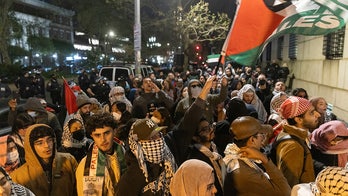A federal judge is poised to issue a ruling any day in the controversial case of a painting hung at the U.S. Capitol depicting a police officer as a pig.
Judge John D. Bates heard arguments Wednesday over whether the architect of the U.S. Capitol must rehang the painting deemed by some as offensive and “anti-police.”
The acrylic painting, called “Untitled #1,” was the creation of David Pulphus when he was a student at Cardinal Ritter College Prep high school in St. Louis.
The painting appears to show a pig in a police uniform aiming a gun at a black wolf holding a sign that says, “STOP KILL.”
Above the scene, two birds -- one black, one white -- fight, and beside them, an African-American protester holding a scale of justice is crucified.
Law enforcement groups had strongly objected to the painting’s display on the Capitol complex grounds, with one group calling it “reprehensible, repugnant and repulsive.”
The art work was part of an annual contest sponsored by Rep. William Lacy Clay, D-Mo., and is said to be a symbolic representation of injustice, inequality and the unrest in Ferguson following the shooting of an unarmed black man by a white police officer in 2014.
The painting had hung in a tunnel leading to the Capitol for more than seven months before it became a lightning rod of controversy.
Rep. Duncan Hunter, R-Calif., took the painting down and returned it to Clay’s office last year. Hunter argued that it was inappropriate. Clay put it back up.
A few days later, Colorado Republican Rep. Doug Lamborn removed it again, arguing it didn’t belong at the Capitol.
Republicans eventually issued a formal complaint that led to the architect of the Capitol removing it in January.
Clay filed a federal lawsuit over the removal of the painting, arguing that it violated constitutional rights of expression.
A central argument brought up in Wednesday’s hearing was whether the painting was government speech or private speech in a public forum, according to the St. Louis Post-Dispatch.
Assistant U.S. Attorney Marina Braswell argued that the government’s message in holding the art competition was in support of young artists and that since it was commissioned by the government, it gave the architect of the Capitol editorial control on what artwork should be displayed and where.
The lawyer for Clay and Pulphus argued that the government’s claim that it was “supporting artwork” was too broad to count as a government-sanctioned speech.





